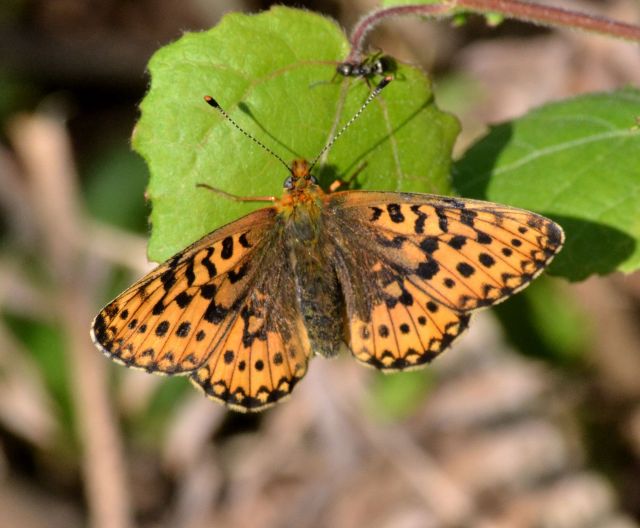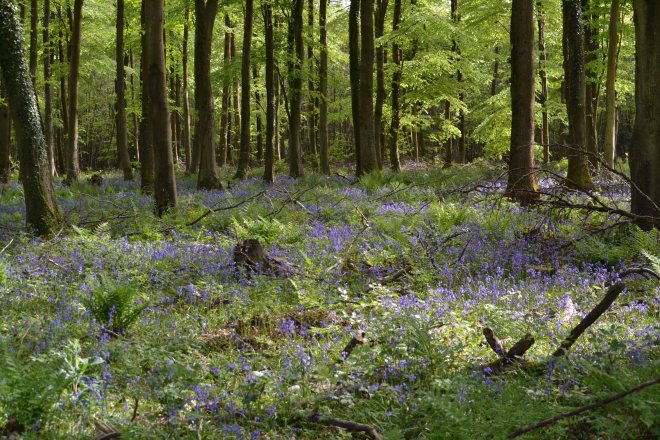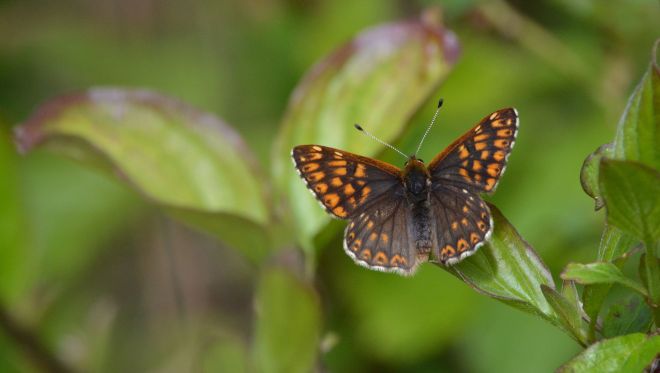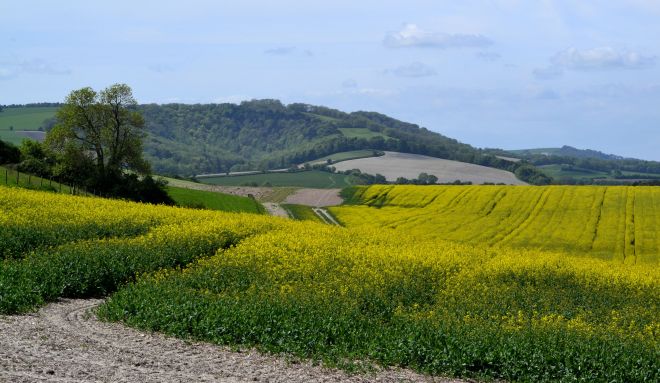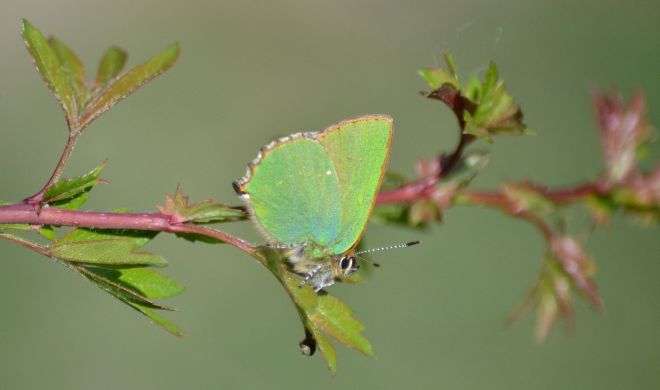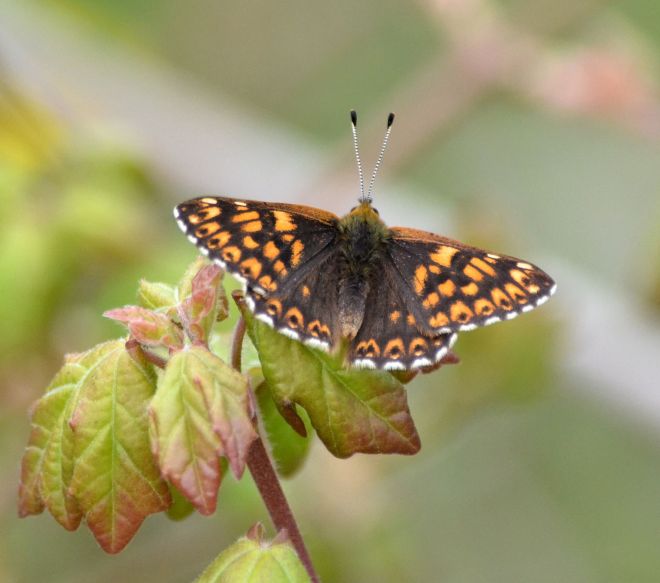Given this month’s now prolonged window of sunny weather, insect emergence in the new season appears to be back to normal after a wet early spring. Since last visiting the butterfly mecca of Cotley Hill, Wiltshire in 2015 (see here) it had been a vagueish aim to compare Marsh Fritillary numbers across three more hills – Scratchbury, Middle and Battlesbury – that lie north-westward at the bottom left corner of the Salisbury Plain military training area.
On consulting Butterfly Conservation’s Wilts county web site (see here) on Friday evening, most of the recent Marsh Frit sightings were coming from the most north-westerly site, Battlesbury Hill (ST898456) on the edge of the aptly named garrison town of Warminster. A good spread of other spring species was also being observed here, including Duke of Burgundy. So as Ewan had contacted me during the day to ask if I was butterflying this weekend I suggested we make this our latest destination, and he agreed.
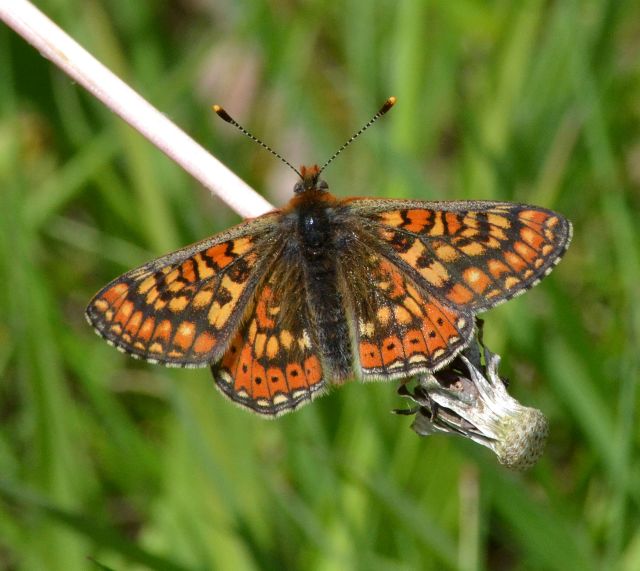
The delicate stained-glass petals that are Marsh Fritillary
Amongst iron age hill-forts Battlesbury is certainly formidable, sitting atop a very steep, round hill upon which rise as steep ramparts. Our prehistoric forebears were certainly no mugs in selecting sites on which to build these enclosures to provide safe haven for local communities during times of unrest. Battlesbury and it’s neighbour Scratchbury (ST911443) dominate the Wylye valley to the south from the scarp edge of Salisbury Plain, and each site has fine views of the other. Battlesbury is an example of the type of late iron age fortification where multiple lines of ramparts follow the contours of a hill top, with intervening ditches and complex entrances. Scratchbury, just 1.5km away is a simpler and roughly rectangular structure.
These ancient sites are accessed via a public right of way starting from MoD facilities in a road named Sack Hill (ST89923 46476) NE of Warminster town centre. Once reached the ramparts of Battlesbury Hill are an impressive prospect (pictured below). The natural chalk grassland of the Defence Estates-owned enclosure is grazed by cattle to maintain a tussocky structure and 30-40 plant species may be found within just one square metre. This all provides ideal habitat for a diverse range of insects, as well as birds.
Whenever I take other Oxon birders out to see insects I notice a twitching impatience to connect as quickly as possible with whatever it is we are looking for. I am content to explore the location first to see what’s there and eventually enjoy due communion with what is discovered. Observing insects cannot be hurried and in any case once found they are unlikely to fly off somewhere else as birds might do. For these reasons I was happy to follow our separate inclinations at first while keeping in touch by phone.
At first it seemed there were not many butterflies around. The species encountered most often on the hill’s south side was perhaps surprisingly Wall Brown. I can recall visiting this region several times in the early years of this decade to look for them, only ever finding ones and twos. Today’s evidence was that they must now be faring rather better. This is most often an unco-operative butterfly to approach and photograph so a grassy record shot (below left) will have to suffice for this post. Limited numbers of Small Heath (right) were also on the wing.
On reaching the eastern ramparts I began to notice butterflies below me with a lighter, more delicate jizz than the similar-sized Walls. These were indeed the Marsh Fritillary of our intention and I edged down the slope a little to attempt some first pictures. Then I called Ewan who in the event was walking up quite close behind me. And so with our prime target species in the bag my companion now relaxed more and began to enjoy this stunning location and its myriad butterfly life. And there was plenty more to come.
From this point onward there were numerous Marsh Frit wherever we trod. Though a butterfly of conservation concern in England, in my experience where it does occur it is abundant. There must have been hundreds of them here, offering an experience that certainly matched my visits to Cotley Hill between 2011 and 2015. This is a very photogenic insect with the pleasing trait of resting on flower and seed heads with wings spread gloriously open and flat. And what a picture they make (below) with beautifully marbled upper wings perhaps suggestive of stained glassware.
Several other notable spring species were active here since the east-facing slopes, especially between the upper and lower ramparts were sheltered and warm, facing directly into the sun. Busy Dingy Skipper buzzing about and basking Small Copper were both present in good numbers, as well as a few Brown Argus. All of the butterflies mentioned so far, other than the Dingy were my first records of the year. Fairly frequent Green Hairstreak also encountered were mostly past their prime and becoming worn.
When we reached the fort’s eastern entrance we crossed over to the outer rampart to walk back around the lower ring, reasoning the north side of the hill would probably be less productive. From here there were panoramic vistas (below) over the area described earlier in this post, and the military training land to the north. The connecting right of way was visible across the two hills to the south-east. I at once conceded my original plan of tracking Marsh Frit numbers all along that route would probably have been ambitious to achieve.
A short distance back round the lower circuit, another butterfly enthusiast below us drew our attention to two Adonis Blue (pictured below) he had found. For this bright herald of shortly arriving summer to be on the wing here in mid-May is a good indicator that the 2018 butterfly season is nicely back on track. And all the while we continued to be delighted by the dancing, gliding and ever delicious delicacies that were the Marsh Fritillaries.
Back at our start point, the western fort entrance, of the species on our wish list we had yet to see Grizzled Skipper and Duke of Burgundy. Two other observers advised us to look for the latter around some Beech hangings on Battlesbury Hill’s southern slopes. We then took a lower path still, and in some Hawthorn scrub habitat I picked out two fresh looking Dukes staking out exposed twigs or grass heads. This was my fifth different site for the species so far in May, and once again “His Grace” rather stole the show (below).
Lastly we made our (or at least my own) weary way back uphill then crossed the hill top to see if Grizzled Skipper could be found in the open area within the prehistoric enclosure itself. But that little butterfly remained our one miss of the day and we headed back to the car satisfied with having obtained an almost full set. An exercise monitoring app Ewan uses on his i-phone revealed we had trodden a total of seven miles in enjoying another highly rewarding butterfly outing while re-acquainting ourselves with the so pleasing and attractive Marsh Fritillary.













